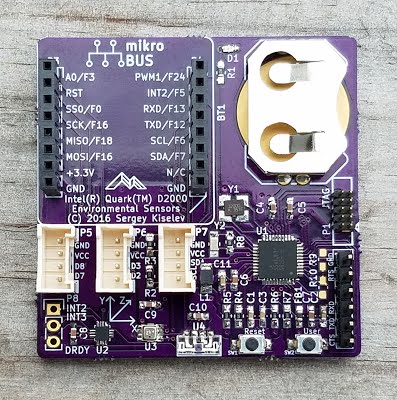Introduction
This is a fairly small (51 x 51 mm) board, equipped with a low power Intel Quark D2000 microcontroller, and several sensors (accelerator, temperature, humidity, atmospheric pressure), as well as a mikroBUS compatible header and a Grove compatible connectors, that can be used to connect additional sensors, memory, or radio modules. The board can be used to monitor the environment conditions, and store or transmit the data to a remote system for further processing.
Design Overview
Microcontroller
Microcontroller Overview
The board uses the Intel Quark D2000 microcontroller (U1). This microcontroller contains a 32-bit x86 processor core, 25 GPIOs, I2C, SPI interfaces, JTAG, two UART interfaces, PWM module, timers, and so on. It includes 32 KiB of the instruction Flash ROM, 8 KiB of the SRAM, and a few kilobytes of the OTP memory (which is actually a Flash ROM which can be write/erase protected).
Clocks
The microcontroller runs on a 32 MHz clock provided by quartz resonator Y1, it also uses a 32768 Hz quartz resonator Y2 for RTC clock.
Power Supply
The microcontroller includes an on-chip 1.8V buck converter voltage regulator to supply voltage for the CPU core. The 47 uH inductor L1 and the 4.7 uF capacitor C11 are the external components used by the voltage regulator. The ferrite EMI filter FB1 and the capacitor C7 form an LC filter for filtering the analog supply voltage AVDD. The I/O power supply IOVDD rail, as well as all the on-board sensors are connected directly to the CR2032 battery BT1 (nominally 3V). All the power supply rails are bypassed using 1 uF capacitors.
Reset
The board uses a simple RC reset circuit implemented using the resistor R4, the capacitor C1, and reset switch SW1. The Quark D2000 MCU has a hysteresis on RST_N input, which ensures the proper reset signal generation using an RC circuit.
GPIO Pins Allocation
The GPIO pins of the Quark D2000 MCU are allocated on this board as shown in the table below. Note that GPIO pins have multiple functions (modes), and they need to be configured in the software according to the function used by this board. The suggested pin functions are marked with italic bold.


